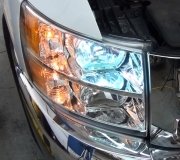Turn on your hazard light switch. Are your tail lights flashing?
The reason I ask - they use the same light filament inside the bulb. If they work, then the bulbs are okay. Another way to check each bulb is to take one out and see if the other starts to work. If one miraculously starts to work when the other is subtracted from the equation - then your problem could be that bulb in your hand, or the socket it goes into. My guess is neither, but could be something that simple.
How's the seal on the front windshield? These are notorious for leaking. And when they do, water drips into the driver's feet. Do you get wet when it rains really hard? If so - I might start looking there. The water leak is from the windshield frame seal - typical design flaw of the vehicle and common problem to the vehicle. If it's leaking, a quick fix is to take some silicon and run it along the inside of the rubber seal to prevent water from getting in. (Many people would generally change out the seal at the same time but if it's in good shape and you have a steady enough hand to keep the silicone only where you want it - then I wouldn't bother - it's cosmetic more than anything else)
Water leaking at the feet is a bad thing though, as it messes up all the contacts of the various electrical components under the dash, particularly for the stereo, fuel gauge, temp gauge, oil pressure gauge, voltage meter, and oh yeah - brake light sensor on the pedal. Take a look at the very top of your foot pedal for the sensor. If the contacts are rusty - could be the answer you were looking for. Just remember - don't do anything silly like unscrewing bolts / components on that brake pedal - we wouldn't want you doing anything that could result in you not having brakes now! Lights are one thing, the brakes themselves. Completely another topic! Lol!
Happy electrical hunting!
SPONSORED LINKS
Sunday, June 8th, 2008 AT 4:59 PM



